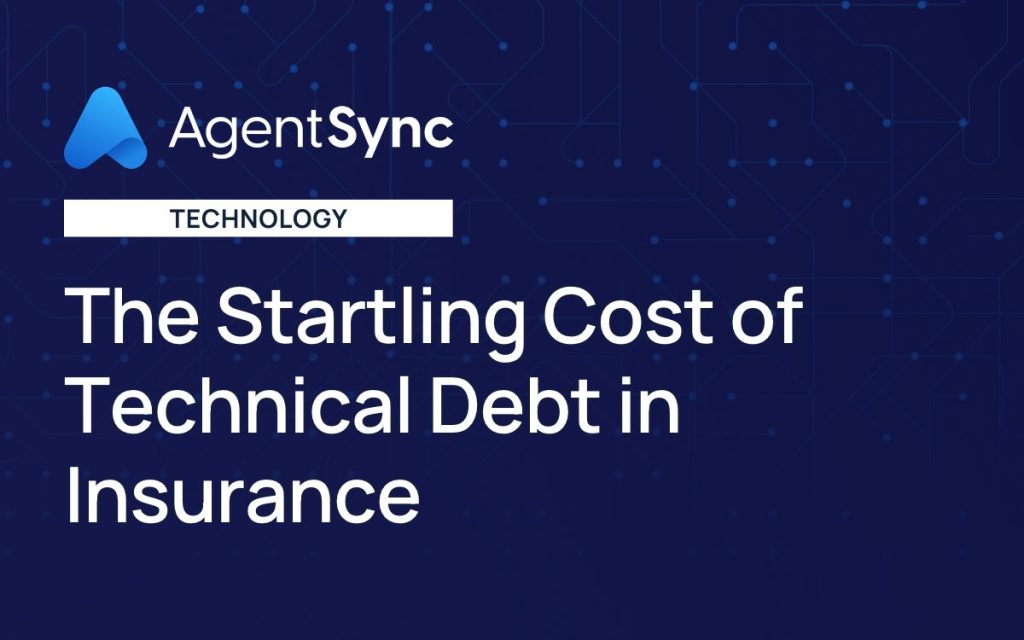The Startling Cost of Technical Debt in Insurance

Concerns over cost are a common culprit when it comes to choosing business as usual over making changes or improvements to outdated technology and processes. Thinking the cost of implementing modern solutions will be far greater than the cost of maintaining their current, legacy technology can put insurance organizations into technical debt and negatively impact their opportunity for growth.
What is technical debt?
Technical debt refers to the time, money, and resources an organization should be spending on software development compared to the cost of keeping its legacy solutions running. Put simply, technical debt accrues when an organization prioritizes “business as usual” over innovation.
Businesses often end up in technical debt for the same reasons people with medical needs put off getting help – to put off doing something they don’t want to do. Like an individual who deals with tooth pain for months to avoid going to the dentist, organizations get into technical debt to avoid the research required, the time spent, and the money needed to update their outdated technology.
However, similar to putting off a visit to the doctor or dentist, going into technical debt is only a short-term solution to a problem. While the consequences are more immediate for the individual dealing with a toothache, who will likely only last a few weeks avoiding the dentist until the pain becomes too unbearable, it can take longer for a business’s technical debt to catch up.
That’s no reason to put off updating your legacy technology. While it may not be in the next five months or even the next five years, eventually technical debt will come back to haunt those who choose to ignore it and, when it does, it’s likely going to be a much bigger problem. Just take the end of 2022 Southwest Airlines catastrophe for instance.
Technical debt in the insurance industry
The “if it ain’t broke don’t fix it” line of thinking has long been used by insurance experts to avoid investing in modern solutions. And while the technological revolution has inspired a great deal of agencies, carriers, and MGA/MGUs to rethink the way they approach insurtech, not everyone has been convinced.
We get it, overhauling an entire system is no small task. Which is why some organizations are still relying on legacy technology, spreadsheets, and manual processes to get the job done.
Sunk-cost fallacy can halt innovation
What’s stopping people from upgrading their old tech? You know, besides the hassle of trying to move a decades-old system with massive amounts of data. Unfortunately, sunk-cost fallacy has a tendency to stop technological innovation in its tracks.
Human nature tells us it makes more sense to keep investing money in legacy technology because surely that will cost less than overhauling the entire thing in favor of new solutions. One serious, valid concern for large-scale carriers: Moving to a new system can mean unhooking other systems and potentially affecting millions of data points for hundreds of thousands of producers. We get it, the tech you have right now gets the job done.
However, sunk-cost is called a fallacy for a reason. While the costs and risks in restructuring your techstack for modern insurance infrastructure are real, many organizations don’t even realize the exposures that are already built into their current way of doing business.
How does technical debt increase the cost of doing business in insurance?
Allocating funds to legacy technology maintenance and updates may give off the appearance of cost savings, heck it might actually save an organization money in the short term, but it likely won’t stay that way. Sure, technical debt can save your insurance business the money you would spend on new solutions, but it’s also costing you a lot in the long run. Let’s explore a few of the ways that outdated insurtech can affect your bottom line.
1. It wastes employee time
Your people keep things running at your organization; don’t slow them down with repetitive, manual processes that could be accomplished by an automated system. Take producer licensing, for example. If business as usual at your carrier means your onboarding team is bogged down with redundant data entry and heaps of paperwork just to validate existing licenses or secure appointments for each new distribution partner, it’s safe to say you’re not maximizing anyone’s time or talent.
2. It opens you up to compliance risk
Processes that involve a significant amount of human touch (i.e. spreadsheets and manual data entry) also have a higher chance of human error. While the manual method may work for some, agencies that manage a large number of producers (each working across multiple states and with various carriers) know how complex compliance management can quickly become.
Just think of all the extra costs a carrier working off a manually coded system had to pay to adapt when states like Massachusetts and Kansas completely overhauled their state appointment systems. Without updating to an automated compliance management solution, an agency could open itself up to a higher risk of compliance violations.
3. It makes recruiting new talent a lot harder
We’ve already established that the insurance industry is currently facing a talent crisis. Competing for top talent from a shrinking pool of applicants means offering an exceptional employee experience – something that’s a lot harder to do when outdated tech makes the job more tedious and less efficient. Without new talent, growing your client list and securing a future spot in the market might prove challenging.
These are just a few of the ways technical debt is costing your agency, carrier, or
MGA/MGU. Download our guide on the cost of doing nothing for a more in-depth analysis on how business as usual can chip away at your bottom line.
The cost of outdated tech is more than the sum of its parts
We’re not trying to sugar coat the difficulty of updating your legacy systems. It’s a time-consuming task that most organizations have the best intentions to eventually complete. But how many manual errors and dropped records are going unaccounted for in the meantime?
The impacts of technical debt are both direct in the way they eat up your budget and indirect in the way they inhibit growth by making your agency, carrier, or MGA/MGU a less desirable partner, employer, and merger and acquisition candidate. Overall, the cost of relying on outdated tech is probably costing you a lot more than it would to replace it.
AgentSync can show you how affordable investing in a new solution can be. If you’re ready to trade business as usual for increased efficiency and decreased risks, see what AgentSync can do for you today.

